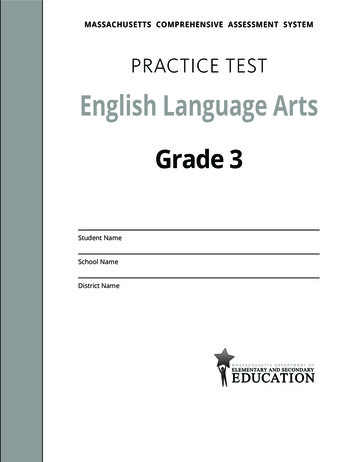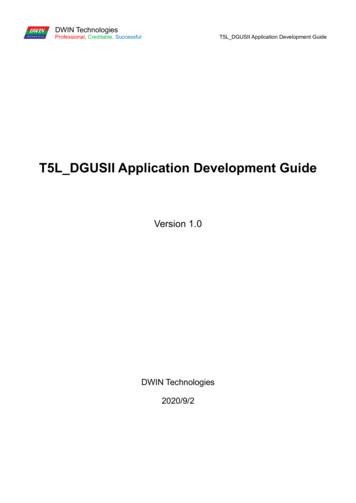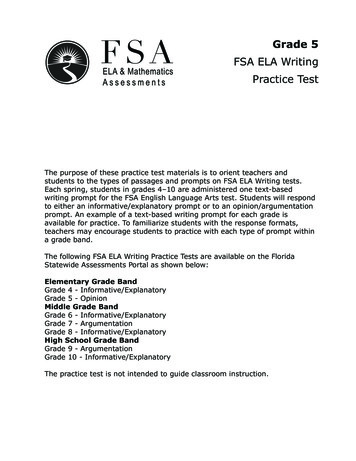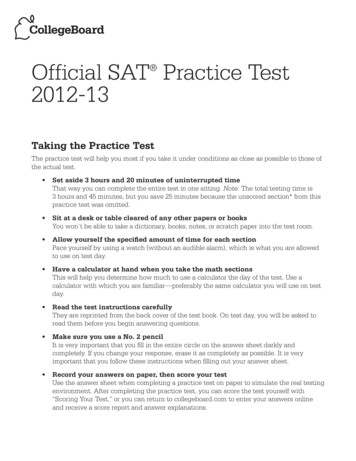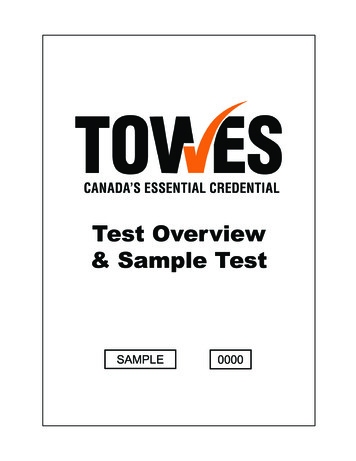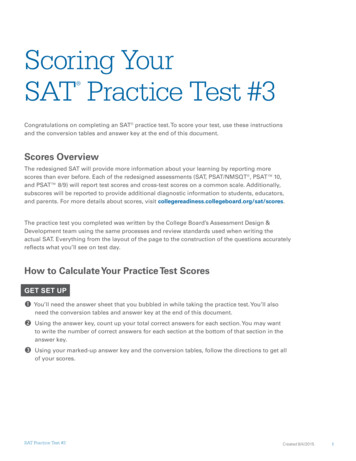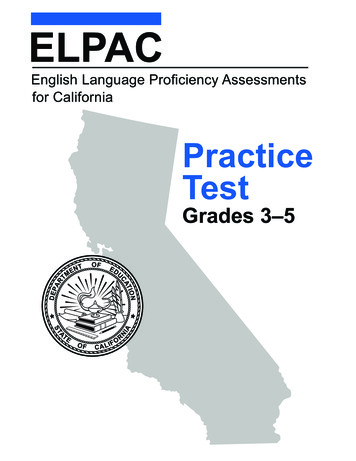
Transcription
ELPACEnglish Language Proficiency Assessmentsfor CaliforniaPracticeTestGrades 3–5
Copyright 2017 by the California Department of Education (CDE). All rights reserved. Copying and distributing these secure materials fortraining purposes is limited to those individuals in California local educational agencies who have signed the ELPAC Test Security Affidavit.These materials may not be edited or altered, and must remain unchanged as published by the CDE. Any other use or reproduction of thisdocument, in whole or in part, requires written permission from the CDE.
Table of ContentsIntroduction2Uses of This Document3Listening Listening Overview4 Listen to a Short Exchange5 Listen to a Classroom Conversation6 Listen to a Story8 Listen to an Oral Presentation10 Reading Overview12 Read and Choose a Sentence13 Read a Short Informational Passage14 Read a Student Essay15 Read a Literary Passage18 Read an Informational Passage21 Writing Overview24 Describe a Picture25 Write About an Experience28 Write About Academic Information30 Justify an Opinion32 Speaking Overview34 Talk About a Scene35 Speech Functions37 Support an Opinion38 Retell A Narrative39 Summarize an Academic Presentation41ReadingWritingSpeakingAdditional Resources44
IntroductionWhat is the ELPAC?The ELPAC, or English Language Proficiency Assessments for California, is the state’s English languageproficiency test for students whose primary language is other than English. The ELPAC helps to identifystudents who need help in learning English, so they can get the language support they need to do well inschool and access the full curriculum. Every year, students who are English learners take the ELPAC tomeasure their progress in learning English.The ELPAC is administered at these grades/grade spans: Kindergarten Grade one (1) Grade two (2) Grades three through five (3–5) Grades six through eight (6–8) Grades nine and ten (9–10) Grades eleven and twelve (11–12)All grades/grade spans have test questions in four different domains: Listening, Reading, Writing, andSpeaking. The Speaking test questions are administered one-on-one by a Test Examiner at all grades/gradespans. At kindergarten and grade 1, all test questions are administered one-on-one by a Test Examiner. Atgrades 2–12, Listening, Reading, and Writing sections are administered to groups of students.What is the purpose of the Practice Test?The Practice Test gives students, parents and families, teachers, administrators, and others anopportunity to become familiar with the types of test questions on the ELPAC. When studentsknow what to expect on the test, they will be better prepared to demonstrate their English languageproficiency.The Practice Test includes examples of all of the types of questions that may appear in the actualassessment 1 but does not include the full number of questions that appear on the assessment.The practice questions in this document include directions for the Test Examiner and test content forthe student. The SAY symbol is used to indicate directions that the Test Examiner reads aloud to thestudent. During an actual test administration, the Test Examiner directions are not visible to the student.Note that the Practice Test cannot be used to provide an ELPAC test score. The Practice Test can beused to familiarize students with the ELPAC test questions and tasks they will be asked to complete todemonstrate their English language proficiency.12On the Practice Tests, the same test questions may be included at multiple grades/grade spans when the question types are similar across those grades/grade spans. On the actual test, there are no common questions across grades/grade spans.IntroductionELPAC Practice Test—Grades 3–5
Uses of This DocumentFor StudentsStudents can use this Practice Test to: Become familiar with the question types Learn how to provide their answersBy reviewing the Practice Test before the test day, students will understand what they will be asked to do.As a result, students will be able to focus on demonstrating their English language skills on the test day.For Parents and FamiliesParents and families can use this Practice Test to: Understand the types of English language skills that students are expected to develop Understand what students need to be able to do on the actual test Understand the types of test questions that contribute to ELPAC test scoresBy reviewing the Practice Test in advance with their children, parents and families can also help studentsprepare for the test.For TeachersTeachers can use the Practice Test to: Understand the types of test questions that appear on the actual test Understand the alignment of the test questions with the 2012 California English LanguageDevelopment Standards, Kindergarten Through Grade 12 (2012 ELD Standards) Review with students and their families and help them become familiar with the test questions Create similar tasks for instructional purposes, with appropriate support, for their studentsOf course, teachers should also have their students practice a variety of exercises that do not appear onthe ELPAC to help students develop in all areas described by the 2012 ELD Standards.For AdministratorsAdministrators can use the Practice Test to: Become familiar with types of test questions Communicate with students, families, and teachers about the skills assessed in the testAdministrators can also use the Practice Test as a resource when creating professional developmentopportunities for educators.For more information about the ELPAC, please review the Additional Resources section at the end ofthis Practice Test.ELPAC Practice Test—Grades 3–5Uses of This Document3
Listening OverviewThe goal of the Listening domain in an actual test setting is to provide information about an Englishlearner’s ability to listen actively and interpret and comprehend grade-appropriate and increasinglycomplex spoken English (e.g., conversations, stories, and oral presentations) in a range of social andacademic contexts.The Listening task types include stand-alone questions as well as sets that include a conversation, story,or presentation followed by one to four questions. These oral presentations mimic the language studentshear and need to understand to engage in school-based social interactions and academic activities. Thelanguage students hear at school varies by the speaker, the speaker’s audience, and the context in whichspeaking occurs. The different Listening task types reflect this variation.Conversations, stories, and presentations are developed so that proficient listeners can comprehend allof the information needed to respond to the corresponding questions. The questions test comprehensionof important parts of the oral presentation and do not require that students memorize small details.To decrease students’ need to memorize as they listen, the conversations, stories, and presentationsinclude appropriate context; that is, they include enough information so that meaning is clear. Theconversations, stories, and presentations also include language that reinforces important points andpresents new concepts clearly.All Listening questions are multiple choice with three answer choices. Each of the Listening questionsis aligned with one or more of the 2012 ELD Standards. Alignment with the standards is provided witheach task type on the pages that follow.In grades 3–5, the Listening domain is administered in a group setting. The directions, conversation orpresentation, questions, and answer choices are delivered via audio recordings that are played througha secure online portal. Note that the audio recordings are not provided with this Practice Test; however,the audio scripts are included.Answer Key: 1. A, 2. B, 3. A, 4. C, 5. C, 6. B, 7. A, 8. C, 9. A, 10. B, 11. A4ListeningELPAC Practice Test—Grades 3–5
LISTENINGListen to a Short ExchangeIn this task type, students listen to a recording of a short conversation between two speakers in a schoolcontext. Students then answer one question about the conversation.Aligned 2012 ELD Standards: PI.A.1, PI.B.5, PII.A.2 2NarratorListen to a conversation between a girl and a boy. Listen carefully. You will hear theconversation only once. After listening, you will answer a question.GirlI love how we can mix paint together to make new colors. But when we mix red and blue paint,it’s supposed to turn purple.BoyYou’re right, but this still looks blue. We need to add more red paint to the bowl.1Why are the girl and boy going to add more paint to the bowl?A because they want the paint to change colorB because they do not have enough paint for their picturesC because they are following the teacher’s directions2The standards have been labeled to indicate Part I, Part II, or Part III (PI, PII, PIII); the mode (in PI, A Collaborative, B Interpretive, C Productive)or process (in PII, A Structuring Cohesive Texts, B Expanding and Enriching Ideas, C Connecting and Condensing Ideas); and the standardsnumber (in PI, 1–12; in PII, 1–7). For the 2012 ELD Standards, please see the link in the Additional Resources section.ELPAC Practice Test—Grades 3–5Listening5
LISTENINGListen to a Classroom ConversationIn this task type, students listen to a recording of a conversation between two speakers in a classroomcontext. Students then answer three questions about the conversation.Aligned 2012 ELD Standards: PI.A.1, PI.A.3, PI.B.5NarratorListen to a conversation between a boy and a girl. Listen carefully. You will hear theconversation only once. After listening, you will answer some questions.BoyWow! The school book fair has so many tables. When I carried books inside this morning, thetables weren’t here yet.GirlI know! Could you give me a hand putting the snacks out?BoySure! There’s space on the table near the door—let’s put the snacks there.GirlGood idea. So—what kind of books are you going to look for?BoyI like stories about nature—you know, books that talk about different plants and animals. Whatabout you?GirlI recently started reading adventure books, but I’m not sure they’ll have any. When we finishworking, let’s ask Mrs. McBride about the books they’ll have here today. She’s the teacher incharge.6ListeningELPAC Practice Test—Grades 3–5
2What are the students doing?A cleaning tablesB setting up a school eventC studying in the school library3What kinds of books does the boy like?A books about natureB books about outer spaceC books about adventure4What will the students probably do next?A eat some snacksB read booksC talk to a teacherELPAC Practice Test—Grades 3–5Listening7
LISTENINGListen to a StoryIn this task type, students listen to a recording of a short fictional story that contains dialogue. Studentsthen answer three questions about the story.Aligned 2012 ELD Standards: PI.B.5, PII.A.1NarratorListen to a story. Listen carefully. You will hear the story only once. After listening, you willanswer some questions about the story.WomanAvery packed her backpack for school like she always did. But today was different. TodayAvery was going to be in a speech contest after school.Avery had finished writing her speech weeks ago, and she practiced saying it every night. Shepracticed in front of the mirror and her family, and she even practiced outside.Avery couldn’t wait until the speech contest. She barely ate lunch, and it was hard to payattention in class. Finally, when the school day was over, Avery walked to the school auditoriumwith the other students. She reached into her backpack to pull out her speech—but her speechwasn’t there!“Oh, no!” Avery thought. “It must be at home!” She felt nervous.Just then, she heard the principal call out her name: “Next up, Avery Thompson.” Avery heardthe audience clap.She slowly walked onto the stage. She thought to herself, “How can I say my speech withoutmy paper?” Avery took a deep breath. As she looked out at the faces in the audience, it waslike she was looking in the mirror at home, or at her family. She started to feel less nervous.“I’ve practiced so much, I don’t even need the piece of paper,” Avery thought to herself. Andthat’s when she started saying her speech, word-for-word, with confidence, and withoutneeding to read it.8ListeningELPAC Practice Test—Grades 3–5
5What happens in the story?A Avery is practicing a new sport.B Avery is planning an event with her friends.C Avery is getting ready for a contest.6Why is Avery nervous?A She forgot to turn in her homework.B She left something at home.C She did not practice her speech.7What happens at the end of the story?A Avery gives a speech from memory.B Avery sings a song on stage.C Avery watches a school play.ELPAC Practice Test—Grades 3–5Listening9
LISTENINGListen to an Oral PresentationIn this task type, students listen to a recording of an oral presentation on an academic topic. Studentsthen answer three or four questions about the information. For the Practice Test, there are four questionsincluded. During an actual administration of this task type, students may take notes in their Test Book.Aligned 2012 ELD Standards: PI.B.5, PI.B.7, PI.B.8, PII.A.1NarratorListen to a teacher talking to his students about apples. Listen carefully. You will hear theinformation only once. After listening, you will answer some questions. As you listen, you mayuse the blank areas in your Test Book to take notes.ManHave you ever noticed when you’re eating an apple that the inside part that’s usually whitewhen you first bite into it starts to turn brown after a while? Why does the inside of an applestart to turn brown?Well, it’s because of what apples have inside of them. Apples have a lot of iron in them. Ironis a metal, and it’s also a mineral that’s important for our health. It’s the iron in the apple thatmakes it turn brown. When you bite into the apple, oxygen in the air touches the iron in theapple. When this happens, the apple starts to turn brown. Some people call this “rusting”—youknow, just like the rust you might see on old bicycles or old metal tools. These things get rustyfor the same reason—oxygen in the air touches the iron in the metal. Now, for an apple, theskin protects the inside from touching the air. But once you take a bite and break the skin, theiron and oxygen begin to react with each other.Now, if you don’t want to eat brown apples, there are some things you can do to slow down33What happens at the end of the story?the process. After you cut the apple, you can squeeze lemon juice onto it or dip it in a glassAvery gives a speech from memory.of orange juice. ASomefruits, such as lemons and oranges, contain citric acid, and citricBAverysings a song Youon stage.acid will slow down the browning.can just put the sliced apple in the refrigerator. CoolC slowAvery watchesa schoolplay.temperatures alsodown theprocess.1034ListeningWhat is the teacher mainly discussing?A how to cut an appleELPAC Practice Test—Grades 3–5
8What is the teacher mainly discussing?A how to cut an appleB the difference between iron and other mineralsC why apples change color9What does the teacher say that apples have inside of them?A ironB oxygenC citric acid10 Why is the skin of the apple important?A It keeps air inside the apple.B It protects the inside of the apple from air.C It holds all of the apple’s iron.11 What does the teacher say about old tools?A Oxygen and iron together make them rusty.B Citric acid makes them rusty.C They start getting rusty on the inside first.ELPAC Practice Test—Grades 3–5Listening11
Reading OverviewThe goal of the Reading domain in an actual test setting is to provide information about an Englishlearner’s ability to closely read increasingly complex grade-level text, offer interpretations and ideasabout the text, and analyze how writers use vocabulary and other language resources.The Reading task types include stand-alone questions as well as sets that include a passage or textfollowed by two to six questions. The Reading sets include a wide range of literary and informationaltexts that reflect a variety of genres and topics corresponding to the California Common Core StateStandards for English Language Arts & Literacy in History/Social Studies, Science, and Technical Subjects.These standards correspond to the 2012 ELD Standards. These may include stories, descriptions,procedures, reports, and explanations.The Reading questions are multiple choice with four answer choices. Each of the Reading questions isaligned with one or more of the 2012 ELD Standards. Alignment with the standards is provided witheach task type on the pages that follow.In grades 3–5, the Reading domain is administered in a group setting. Students read the directions, text,questions, and answer choices independently. Students may take notes for all Reading task types duringan actual test administration and are allowed to mark up the Reading passages in their Test Book.Answer Key: 1. C, 2. D, 3. B, 4. C, 5. B, 6. D, 7. D, 8. A, 9. C, 10. C, 11. D, 12. A, 13. C, 14. A, 15. B, 16. B, 17. C, 18. D, 19. C,20. B12ReadingELPAC Practice Test—Grades 3–5
READINGRead and Choose a SentenceIn this task type, students look at a picture. Students then choose the sentence that matches the picture.Aligned 2012 ELD Standard: PI.B.6This page is intentionally left blank.11 sthepicture.A The dog is ripping apart the couch.Thedogis rippingapartthetocouch.B ATheboxis readyto betakenthe post office.Theboxready tobybethetakento onthethepostoffice.C BTheboyis issurprisedmessfloor.Theboysurprisedthe mess insideon thethefloor.D CTheboyis issearchingforbysomethingbox.D The boy is searching for something inside the box.Read the text. Answer Numbers 2 through 5.Bells can get a lot of people’s attention. They are used to tell people aboutmajor events. One bell is even an American landmark. This bell is theLiberty Bell, and it is on display in Philadelphia, Pennsylvania. It is mostwell-known for its large crack. It was rung only on special occasions inhistory. It rang when the Declaration of Independence was signed. It rangwhen the United States Constitution was approved. It used to ring onGeorge Washington’s birthday.The Liberty Bell has traveled to many towns and cities in the United States.In 1915 it even traveled to San Francisco, California, by train. It continuesto be a symbol of freedom for everyone to enjoy.ELPAC Practice Test—Grades 3–5Reading13
READINGRead a Short Informational PassageIn this task type, students read a short informational passage. Students then answer three questionsabout the passage. For this Practice Test, there are only two questions included.Aligned 2012 ELD Standards: PI.B.6, PI.B.7, PI.B.8, PII.A.1, PII.A.2 3Read the text. Answer Numbers 2 and 3.Bells can get a lot of people’s attention. They are used to tell people aboutmajor events. One bell is even an American landmark. This bell is the LibertyBell, and it is on display in Philadelphia, Pennsylvania. It is most well-knownfor its large crack. It was rung only on special occasions in history. It rang whenthe Declaration of Independence was signed. It rang when the United StatesConstitution was approved. It used to ring on George Washington’s birthday.The Liberty Bell has traveled to many towns and cities in the United States. In1915 it even traveled to San Francisco, California, by train. It continues to be asymbol of freedom for everyone to enjoy.2What is the main idea of the text?A Bells can get a lot of people’s attention.B George Washington helped make the Liberty Bell.C The Liberty Bell traveled by train.D The Liberty Bell is an important landmark.3When was the Liberty Bell NOT rung?A on George Washington’s birthdayB at an important event in San FranciscoC at the signing of the Declaration of IndependenceD at the signing of the Constitution314The standards have been labeled to indicate Part I, Part II, or Part III (PI, PII, PIII); the mode (in PI, A Collaborative, B Interpretive, C Productive)or process (in PII, A Structuring Cohesive Texts, B Expanding and Enriching Ideas, C Connecting and Condensing Ideas); and the standardsnumber (in PI, 1–12; in PII, 1–7). For the 2012 ELD Standards, please see the link in the Additional Resources section.ReadingELPAC Practice Test—Grades 3–5
READINGRead a Student EssayIn this task type, students read a persuasive, informational essay presented as if written by a peer. Theessay is related to a school or social issue. Students then answer six questions about the essay.Aligned 2012 ELD Standards: PI.B.6, PI.B.7, PI.B.8, PII.A.1, PII.A.2, PII.C.6, PII.C.7A student has written an essay. The essay may include errors. Read the essay.Then answer Numbers 4 through 9.1 In my opinion educational video games are helpful for many reasons. Kids spendlots of time playing games, so why not learn while playing games? Games let youlearn how to solve problems, see how well you are doing, have fun, and work with ateam.2 Video games also allow you to be creative. Some games let you unlock levels, solvepuzzles, or even build cities.3 Educational video games let children work at their own speed. It’s fun to beat a levelof a game. Kids would want to learn more, so they can level up. Kids can also seehow they are improving. If you beat a level in a math game, you can go to the nextlevel.4 You can learn with your friends and help each other if you play games online.Working as a team makes learning more exciting. Playing games can also help kidsremember things. If it’s fun to practice math facts, you will practice and learn more.Playing video games make kids want to learn. These are the reasons that kidsshould play educational video games in the classroom.ELPAC Practice Test—Grades 3–5Reading15
4What is the main idea of the essay?A Kids spend a lot of time playing video games.B Kids who play video games are good at math.C Video games are fun and help students learn.D Video games help students practice teamwork.5First, read the definitions for the word allow.allow v. 1. to give permission 2. to make something possible 3. to fail tokeep something from happening 4. to acceptThen read this sentence from paragraph 2.Video games also allow you to be creative.Which definition BEST fits the meaning of the word allow in the sentence?A definition 1B definition 2C definition 3D definition 46Read this sentence from paragraph 3.Kids would want to learn more, so they can level up.What is another way of stating this idea?A Kids like to beat their classmates at video games.B Kids enjoy video games more than math.C Video games are better than teachers.D Video games motivate kids to learn.16ReadingELPAC Practice Test—Grades 3–5
7Which sentence BEST explains how video games can help studentsimprove their math skills?A Games let you learn how to solve problems, see how well you are doing,have fun, and work with a team.B Some games let you unlock levels, solve puzzles, or even build cities.C If you beat a level in a math game, you can go to the next level.D If it’s fun to practice math facts, you will practice and learn more.8Read this sentence from paragraph 4.Playing video games make kids want to learn.Choose the correct option to replace the underlined word.A makesB to makeC makingD be made9Which statement is MOST LIKELY true?A The student writer makes good grades.B The student writer has many friends.C The student writer plays video games.D The student writer wants to be a math teacher.ELPAC Practice Test—Grades 3–5Reading17
READINGRead a Literary PassageIn this task type, students read a literary passage. Students then answer six questions about the passage.Aligned 2012 ELD Standards: PI.B.6, PI.B.7, PI.B.8, PII.A.1, PII.A.2Read the story. Answer Numbers 10 through 15.1“How was school today, Ethan?” Ethan’s mom asked as he climbed into the car.She was always curious to know about his day.2“Fine,” Ethan muttered as he began rummaging through his bag. He never reallyunderstood what he was supposed to tell her. It had been a perfectly ordinary day atschool.3“What did you do?” she asked again, trying to start a conversation.4“Nothing,” Ethan replied, now barely listening. He had already turned his attention tothe three text messages awaiting him on his phone.5Ethan’s mom sighed. “I’m pretty sure that I wasn’t this distracted when I was yourage,” she remarked. “Your grandmother and I used to have actual conversations.”6“Huh?” Ethan asked. He hadn’t really been listening.7“Nothing,” his mother replied sadly as she started the car and drove slowly awayfrom the school.8Ten minutes later, Ethan finally looked up from his phone. “What are we doinghere?” he asked, noticing they were at a supermarket he had never been to before.9“Grandma is coming over for dinner tonight and this is the recipe for her favoriteraspberry cheesecake,” Ethan’s mom said as she pulled a piece of paper out of herpurse. “I know this place will have all the ingredients we’ll need. I thought you couldhelp me find the ingredients and then help me make it.”10 Ethan groaned. He hated grocery shopping, and the idea of spending all afternoonbaking instead of playing his favorite video game was not particularly appealing.However, he knew his grandmother would love the cheesecake, so he reluctantlyagreed.11 Surprisingly, Ethan enjoyed finding the ingredients, and, as he helped his mom inthe kitchen when they got home, he realized that he was actually having fun. Ethanenjoyed measuring all of the ingredients while his mom prepared the baking trays.While all of this was happening, the two actually talked, and Ethan rememberedseveral interesting things from school that had happened that day. It was great tosee his grandmother again at dinner too. It had been several weeks since Ethanhad last seen her, and he realized that he had a lot to tell her.18ReadingELPAC Practice Test—Grades 3–5
12 “Wow, Ethan, I don’t think I’ve heard you speak this much in a long time,” Ethan’smom teased as she brought out the raspberry cheesecake that she and Ethan hadprepared.13 “Well, look who’s talking, Norah!” Ethan’s grandmother said gently to his mother.“When you were Ethan’s age, you used to spend your whole life in your room! Andwhen I asked you how school was, you’d just shrug or say nothing.”14 Ethan’s mother turned pink. “That’s not true!” she protested.15 “In fact,” Ethan’s grandmother winked at Ethan, “I had to get her to help me makethis very raspberry cheesecake to even get her to talk to me.”16 From the other side of the room, Ethan’s phone beeped. But Ethan realized that thisconversation with his mother and grandmother was much more interesting.10 What is the main theme of the story?A Learning about ancestors can be interesting.B Working hard at something can be very rewarding.C Enjoying activities together can make relationships stronger.D Technology can make it easier to keep in touch with friends.11 What word best describes Ethan’s attitude at the beginning of the story?A disappointedB independentC confidentD distantELPAC Practice Test—Grades 3–5Reading19
12 Why does Ethan’s mother sigh in paragraph 5?A She is frustrated that Ethan is not talking to her.B She is annoyed that Ethan brought his phone to school.C She is unhappy because she misses Ethan’s grandmother.D She is tired and not looking forward to driving for a long time.13 What can be inferred about Ethan during the car ride to the supermarket?A He was looking forward to baking with his mom.B He was expecting to go to a new supermarket.C He spent the whole time using his phone.D He was listening to music on his phone.14 Why is paragraph 11 important to the story?A It serves to change the tone of the story.B It identifies a conflict between the characters.C It creates suspense by placing the characters in an unfamiliar environment.D It provides more information about an idea mentioned in the previousparagraph.15 What does Ethan’s grandmother MOST LIKELY mean when she says,“Well look who’s talking” to Ethan’s mother?A She is informing Ethan’s mother that Ethan is talking.B She is reminding Ethan’s mother that she used to be like Ethan.C She is telling Ethan’s mother not to interrupt when Ethan is speaking.D She is agreeing with Ethan’s mother that Ethan does not talk very much.20ReadingELPAC Practice Test—Grades 3–5
READINGRead an Informational PassageIn this task type, students read an informational passage. Students then answer six questions about thepassage. For this Practice Test, there are only five questions included.Aligned 2012 ELD Standards: PI.B.6, PI.B.7, PI.B.8, PII.A.1, PII.A.2Read the text. Answer Numbers 16 through 20.Today, voting for government officials is a special right shared by United Statescitizens who are eighteen years old and older. Each person can vote only oncein an election, and voting is done in secret. That means voters do not have totell anyone who they voted for. Although some practices remain the same, somevoting practices have changed over time.A long time ago, in order to vote, you had to be male and own land. This meantthat only a small group of men could vote. Over time, the right to vote wasextended to more and more people. This happened because of the hard workof people like Martin Luther King, Jr. and Susan B. Anthony. With more peoplevoting, new practices were needed.Years ago voting looked very different than it does today. For many years, votingwas not done in secret. Voters had meetings at public buildings. They would raisetheir hands or voices to show who they wanted to vote for. In some cases, voterswould line up on different sides of a room to show who they were voting for.Today, voters go to polling sites where they can vote. In some states, voters marktheir choices on paper slips, called ballots. Some people even send in their ballotby mail. In other places, paper ballots have been replaced with voti
4 Listening ELPAC Practice Test—Grades 3–5 Listening Overview The goal of the Listening domain in an actual test setting is to provide information about an English learner’s ability to listen actively and interpret and compr


